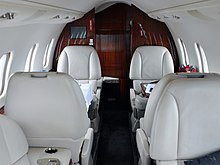|
Learjet 60
The Learjet 60 is a mid-size cabin, medium-range business jet aircraft manufactured by Bombardier Aerospace in Wichita, Kansas. Powered by two Pratt & Whitney Canada PW305A engines, it has a range (with 4 passengers and 2 crew) of 2,405 nautical miles (4,454 km) with NBAA 100 nmi (190 km) reserves, ISA.[2] In July 2012 Bombardier Aerospace announced a temporary "production pause" of the latest variant Learjet 60XR to begin in the fourth quarter of 2012.[3][4] Development The Learjet 60 is an improved version of the Learjet 55, with a longer fuselage and more powerful turbofan engines. It first flew on 10 October 1990 and received FAA certification in January 1993.[5] The modifications that converted the Learjet Model 55 into a Model 60 resulted from an aerodynamics improvement program and a need to increase the capacity of the Learjet product line. Several of these modifications were a first for Learjet, including an all-new inboard wing cuff added to the inboard sections of the “Longhorn” wing and an all-new wing-to-body fairing. By increasing the wing chord and the leading edge droop, the wing cuff improved handling during approach and landing, while the wing-to-body fairing reduced the interference drag between the wing and the fuselage. Since the engines were new for this aircraft, a new engine pylon had to be designed. The lines of the cockpit have not changed but the fuselage was lengthened. In addition, the blend between the fuselage and the empennage was all new. While it appears as if area ruling was the intention of the blending, the blend design was really driven by attaching the original Learjet Model 35 empennage onto the larger Learjet Model 60 fuselage. The final aerodynamic improvements to the Model 60 included the creation of the distinctive "ogive" winglet trailing edge. This lengthening of the chord near the interface of the winglet and the wing improved the interaction of the wing's pressure spike with the winglet's pressure spike. The result was a significant lowering of the drag in this area and a significant improvement of the wing's efficiency. On the prior “Longhorn” wing the interference between the winglet and the wing nearly canceled the effects of the winglet. The single ventral fin was also replaced with two ventral fins that Learjet called "Delta Fins" to improve stall characteristics and promote aerodynamic stability. The Learjet 60 is notable for its time-to-climb performance, climbing to 41,000 feet (12,000 m) in 18.5 minutes at maximum weight. It also distinguished as the last legacy Learjet, using a variation of the wing that designer Bill Lear adapted from the Swiss military aircraft, the FFA P-16.[citation needed] The next-generation Learjet was to be the Learjet 85 and was an all-new design by Bombardier Aerospace slated for delivery in 2013.[6] The Learjet 60, while a tremendous performer, also maintains the highest incident/accident rate in its class with most accidents occurring during landing. The use of the original Lear 23 gear and wheels (albeit it with an added brake rotor, bringing the total to 3 per wheel assembly) left the 60 (and the 55 before it) notably under-geared and under-braked. According to the NTSB most of these failures are caused by pilot-error as the aircraft can be unforgiving.[7] Production of the Learjet 60 ended in 2007 after 318 aircraft had been built. The Learjet 60XR was a variation with upgraded Proline 21 avionics and slight improvements to the cabin, with production beginning at serial number 319. By 2018, a Learjet 60 could be purchased for $1 million or less.[8] Learjet 60XR Bombardier launched a new variant in 2005 designated the Learjet 60XR and following certification deliveries started in 2007. Grandfathered on the 1966 Learjet 24 type certificate,[9] it was built until 2013. It features three-rotor disc brakes, good for 450–600 landings, Rockwell Collins Pro Line 21 avionics, upgraded AHRS and FMS, electronic charts, enhanced MFD and optional XM radio weather. Cabin space is better utilized with five floor plans, LED lighting, better insulation and improved cabin management system. The 60XR has the largest Learjet cabin, its cross-section is competitive but its length is 2 to 5 ft (60 to 150 cm) shorter than other mid-size jets like the Hawker 800XP. The small 265 sq ft (24.6 m2) wing evolved from the Learjet 23, with the tip tanks replaced by winglets, and runway requirements are long for the 23,500 lb (10,700 kg) aircraft.[10] A typically equipped 60XR weighs 940 lb (430 kg) more than the original Model 60, tanks-full payload is 600 lb (270 kg) and four-passenger range is 2,240 nmi (4,150 km). It climbs to FL 410 in 18 min and cruise at 440 kn (810 km/h) TAS with an average fuel burn of 1,300 lb (590 kg)/h. Long-range cruise varies from 387 to 420 kn (717 to 778 km/h) TAS at FL 350–430 and ISA conditions, while normal cruise speed is Mach 0.76 or 436 kn (807 km/h) TAS. The FADEC-controlled 4,600 lbf (20 kN) PW305A turbofans have a 6,000 h TBO and reserves amount to $360 per hour per engine. In September 2018, there were 112 Model 60XRs in service, priced between $2.5 million for a 2007 model to $4.0 million for a 2013 one.[10] OperatorsCivilianThe Learjet 60 is used by private operators, companies and fractional jet operators. Military and government
Incidents and accidents
SpecificationsData from Brassey's World Aircraft & Systems Directory 1999/2000[20] General characteristics
Performance
See alsoAircraft of comparable role, configuration, and era
References
Further reading
External linksWikimedia Commons has media related to Learjet 60. |
||||||||||||||||||||||||
